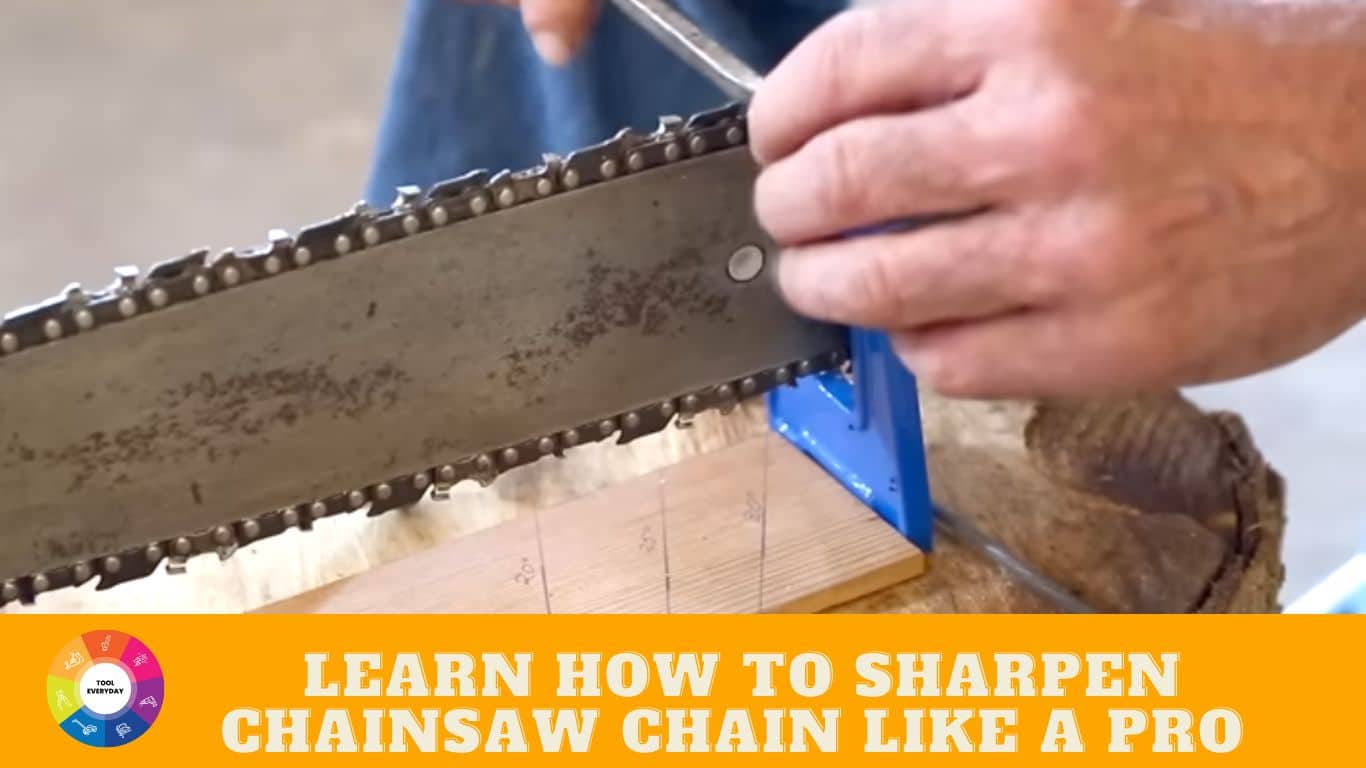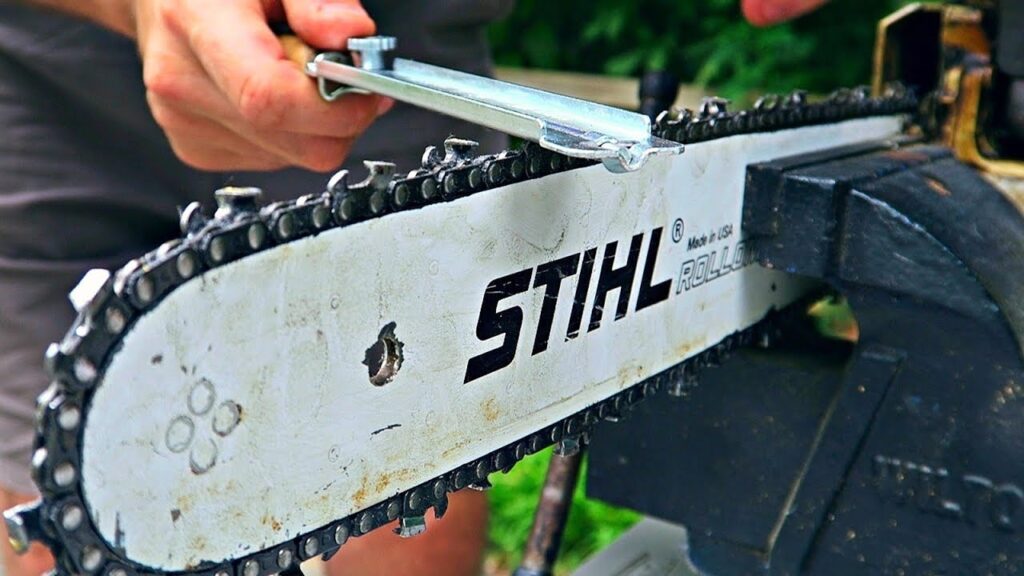For your chainsaw to function optimally, safely and efficiently with clean cuts, it must be kept sharp. Follow these steps to sharpen your chainsaw and maintain its peak performance.
Like any other tool, chainsaws need to be sharpened and maintained consistently. A dull chainsaw is inefficient and dangerous, as cutting takes more effort and may kick back when cutting. If you’ve noticed your chainsaw isn’t cutting as cleanly and easily as when you bought it brand new, it’s time to sharpen your saw’s blade and check for dull or sharpened teeth.
If you’re good with tools, sharpening a chainsaw won’t be that hard. You can save some money by getting your chainsaw serviced by yourself. Of course, you can always get it serviced by a professional if you’re good with tools.
Before sharpening your chainsaw, you’ll need the proper safety gear, such as gloves and eye goggles. You will also need the proper tools for the job, like a round file, flat file and depth gauge tool.
Tools & Materials You Need
- Gloves
- Safety glasses
- Round file
- Flat file
- Depth gauge tool
- Screwdriver
- Towel
- Mineral spirits
Basic Components Of A Typical Chainsaw
Before carrying out routine maintenance of your chainsaw, you need to know the various components of the tool. Most chainsaw models typically include the following parts:
- Engine
- Guide bar
- Chain
- Heel
- Toe
- Notch
- Side plate
- Top plate
- Drive mechanism
- Rivet hole
- Gullet
- Depth gauge
When Should You Consider Sharpening a Chainsaw Chain?
A sharp chainsaw is safe to use and minimizes damage and performance. Fortunately, there are signs to indicate when a chainsaw requires sharpening. If you see any of the following, grab your sharpener and start working.
- Monitor the debris produced by your chainsaw. If you see more dust than sharp wood chips, it indicates that your chainsaw requires sharpening.
- Another indication that your chainsaw chain’s teeth are dull and need to be sharpened is when you find that cutting through wood takes more effort than usual.
- And finally, your chain needs sharpening when the blade begins to pull in one direction. If that happens, you’ll need to sharpen its cutting teeth to achieve an even cut again.
How to Sharpen a Chainsaw
There are two methods to sharpen a chainsaw:
First, you can use an electric chainsaw sharpener. This is primarily for professionals and not really ideal for the general public.
Second, sharpen the chainsaw manually using various sharpening files.
This guide is specific to help DIYers sharpen their chainsaw manually with sharpening tools. To ensure the best performance and safety of your chainsaw, you must use a file that precisely fits the size of each tooth in the chain. The three most common sizes are 3/16-inch, 5/32-inch, and 7/32-inch.
Step 1: Clean The Chainsaw Chain
Before you start, take necessary precautions like work gloves and protective glasses. Then proceed with caution by wiping down the chain of any oil, dirt or debris using an old towel and a screwdriver. Depending on how grimy it is, mineral spirits may also be required. As you clean the chain, ensure that none of the teeth are damaged. If so, don’t bother sharpening your chainsaw; fixing or replacing the chain first is best.
Step 2: Set The Chain Tension
It is essential that the tension of the chain on your chainsaw is set to the appropriate level before you start sharpening. If the tension is too tight, it may be challenging to manoeuvre the round file; if it’s too loose, then the teeth of your chainsaw may not cut as efficiently. Besides, a loose chain increases the risk of dangerous kickbacks and even flying off its guide bar.
Set your chain tension correctly for optimum performance by finding and adjusting the tensioning screw on either side or in front of the saw. Test the chain by pulling it from the underside of the guide bar so that one or two links pull away from it. Now release the chain; under normal circumstances, it should snap directly into position. This means the chain is snug enough. Similarly, if you find it hard to pull the chain away from the bar, it is too tight and needs to be loosened.
Step 3: Stabilize The Chainsaw
Before you start using the chainsaw files, ensure your chainsaw is completely stabilized. We suggest you place the chain in a vise. This will help you to keep the chainsaw stationary while filing, which is essential for accurate sharpening. If you don’t have vise, ask someone to hold it steady while you work on it. Once the chain is stable, rotate it so that you don’t sharpen every tooth at once.
Step 4: Start Sharpening At The Shortest Cutter
Locate the shortest cutter blade on your chain. All of the cutters should have flat tops, so you’ll need to use a flat file to sharpen them. And if all are equal in height, you can start with any tooth. Just make sure to indicate where you began by marking it with a pencil, marker or nail polish so that you continue in one direction when sharpening your chainsaw.
Step 5: File The Teeth At An Angle
Insert the file firmly into the notched section at the head of your cutter. Ensure that you keep it at an angle. Position the file horizontally at an angle of 30-35 degrees relative to the bar. Place the file between each cutter, twisting it to create maximum friction. Once you have filed every second link of your chain, continue moving towards each subsequent one until completion.
Step 6: Sharpen The Other Side Of The Chain
Moving in a reverse direction, meticulously file each tooth you left untouched during your initial pass. Once done, all of the cutters should be roughly equal in height across their surfaces.
Step 7: Inspect The Depth Gauges
Lastly, inspect the “depth gauges” or curved links situated between each of the cutters. Make sure that every depth gauge is shorter than its neighbor cutter. If you find a raker with a height higher than its adjacent cutter, file down the depth gauge until it lies approximately one-tenth of an inch below its corresponding cutter’s height.
Maintaining Your Chainsaw Blade
Regardless of whether you need a chainsaw for cutting firewood occasionally or frequent forestry maintenance, it’s important to know the maintenance requirements of your specific model. To that end, study the manual included with your chainsaw.
Here are some tips:
- Inspect the motor and chain of your chainsaw regularly
- lubricate where necessary
- Always ensure there is sufficient oil in the reservoir before each use.
- Pay attention to the guide bar that holds your chain in place, as it can become twisted or bent from regular usage
Final Thoughts
Now that you understand how to sharpen a chainsaw, keep in mind that the more often it is used, the greater its need for maintenance. If you are running your chainsaw all day, take some time out of your schedule to ensure the chain remains sharp and precise. It is likely that certain areas may wear down faster than others – particularly near the saw’s tip when cutting tree limbs – so be sure to pay these sections extra attention!
Learning how to sharpen your chainsaw chain isn’t difficult, all it requires is paying attention to the details and taking your time when sharpening. With a little bit of practice, you’ll be an expert in no time!

